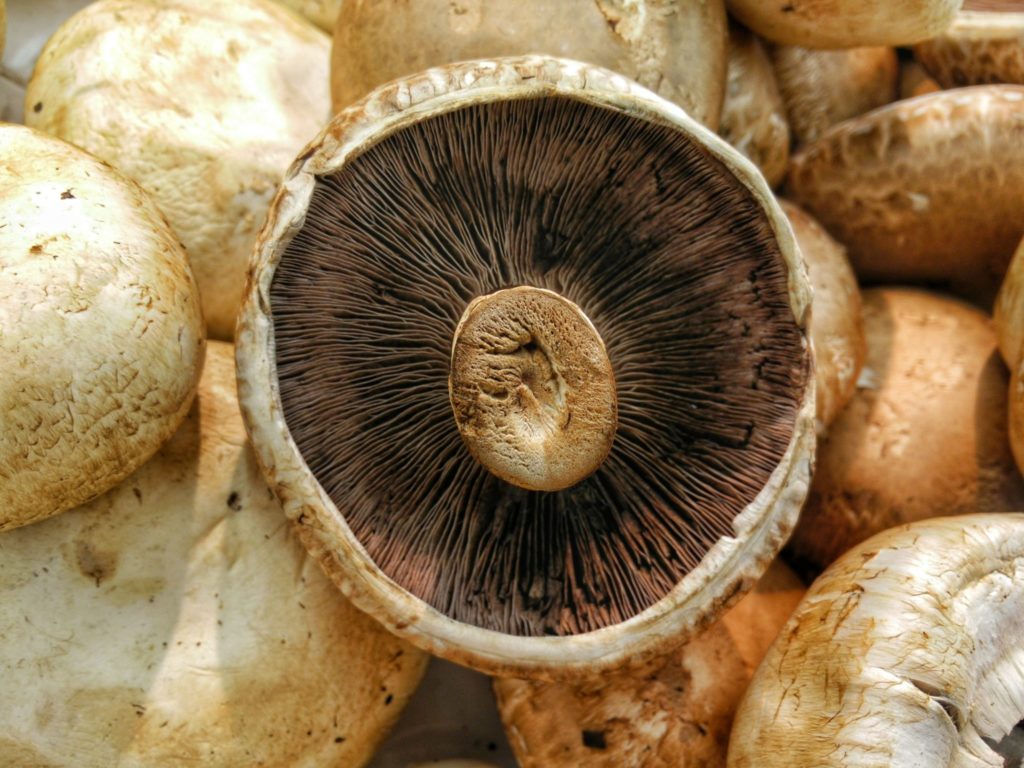Tasty and low-fat, mushrooms come in so many varieties and flavours, making them suitable for so many nutritious recipes. The most common varieties, white button, cup and flat mushrooms, have the botanical name Agaricus bisporus.
If you’re looking for a particular type of mushroom and can’t find it in your supermarket, specialist gourmet and Asian food stores often stock a wide variety of exotic fresh, dried and canned mushrooms. Alternatively, replace the required variety with a more readily available mushroom.
Here is a breakdown of each of the types of mushrooms available in Australia, their flavours and their uses.
 |
Agaricus bisporus – button
Tightly closed around the stem. Available in small, medium and large sizes. Mild flavour. Use in salads, dips, pasta and stir-fries. |
 |
Agaricus bisporus – cups
Beginning to open around the stem, but have no more than 50% of their gills showing. Full-bodied flavour, more developed colour and firmer texture. Use for sautéing, grilling, stuffing or barbecuing. |
 |
Agaricus bisporus – flats
Fully opened. Robust, full-bodied flavour, similar to field mushrooms. Use for pan-fries, stuffing, baking, roasting or barbecuing. |
 |
Swiss brown buttons and cups
Flavour is deeper and more robust than white mushrooms. Use in pasta, risotto, casseroles, or marinade them and add to an antipasto plate. |
 |
Portobello mushrooms
Larger version of the Swiss brown flat. Intense flavour and a dense, meaty texture. Grill, roast or barbecue. |
 |
Oyster mushrooms
Sold as ‘abalone mushrooms’. Fluted, oyster-shell shape and soft texture, available in pink, yellow and grey. The flavour is quite delicate and subtle. They rapidly absorb other textures when cooked. Best cooked quickly over a high heat. Pair well with seafood, chicken, veal and noodles. |
 |
Fresh shitake
Originate from Japan. Rich and woody flavour, with a meaty texture. Taste best when cooked. Remove the stem before cooking. Use in stir-fries, soups, sauces, braise or barbecue. |
 |
Enokitake
These have a mild, fruity flavour and crunchy texture when eaten raw. Use raw in salads or sandwiches, or cooked in soups, stir-fries or Japanese dishes. |
 |
Shimeji
A Japanese variety of mushroom. Trim the base and separate before using. They have a delicate, sweet, nutty-flavoured flesh. Use in stir-fries and pan-frying. |
 |
Chestnut mushrooms
A traditional mushroom from Japan. Use in stir-fries. |
 |
Nameko
Nameko is Japanese for ‘slimy cap’. These have a distinctive crunchy texture with an attractive nutty flavour. Cook the glutinous ‘slime’ away over high heat. Use in stir-fries and miso soup. |
 |
White fungus
Thinly slice and add to stir-fries and Asian-style soups like miso or broth. |
 |
Black fungus
Thinly slice and add to stir-fries and Asian-style soups such as miso or broth. |
Choosing mushrooms
Fresh, white Agaricus mushrooms should have a firm texture, white to cream colouring and a dry surface. Avoid withered or damp mushrooms.
Storing mushrooms
Mushrooms are best stored unwashed in brown paper bags in your fridge, preferably on the lowest shelf. You can also use a cloth bag or clean tea towel to wrap your mushrooms.
It is important mushrooms are packaged in materials that allow them to breathe, so they don’t ‘sweat’ and become slimy. At the same time, opt for a material that won’t dry your mushrooms out too much.
Preparing mushrooms
If you’re eating mushrooms raw, wipe them over with clean, damp paper towel or rinse quickly under cold running water to remove dirt.
There’s no need to peel mushrooms. Apart from being a fiddly job, a lot of the goodness, nutrients and flavour of mushrooms are in the skin. Simply use a soft pastry brush to gently brush any dirt from the surface, and trim the dry end of the stem if necessary.
The stem is a great source of flavour and nutrients. On the rare occasions when you do need to remove the stem, chop it and add to stuffing, casseroles, soups, sauces – even omelettes.
If you’re preparing mushrooms ahead of time for inclusion in a cooked dish, sprinkle them with a little lemon juice to prevent discolouration.
Recipe ideas
Try these great recipes from the Australian Mushroom Growers Association:
- Mushroom antipasto salad
- Mushroom, prawn and asparagus stir-fry
- Pesto-stuffed mushrooms
Mushroom facts
People have been eating mushrooms since Palaeolithic times.
The ‘Iceman,’ discovered in the Italian Alps in 1991 (who was thought to have died 5000 years ago), was carrying dried mushrooms with him.
In the mid 1970s, most mushrooms eaten in Australia were sold in cans. Today, Australians eat 95% of their mushrooms fresh.
A 100 g serving of mushrooms contains more dietary fibre (2.5 g) than 100 g of celery (1.8 g), or a slice of wholemeal bread (2 g).
Nutritional information
Based on 100 g of medium-sized Agaricus cup mushrooms.
| Calories | 23 cals |
| Kilojoules | 98 kj |
| Total fats | 0.5 g |
| Carbohydrates | 1.5 g |
| Cholesterol | 0 mg |
| Protein | 3.5 g |
| Fibre | 2.5 g |

